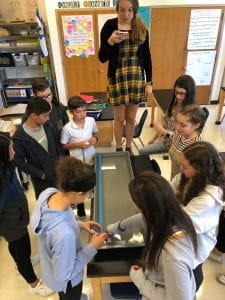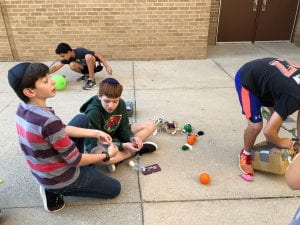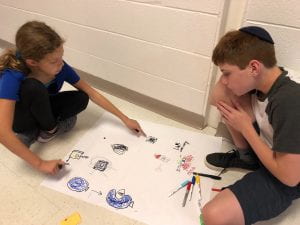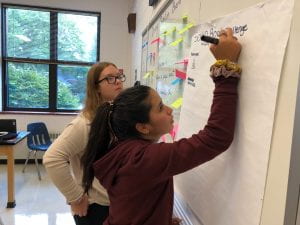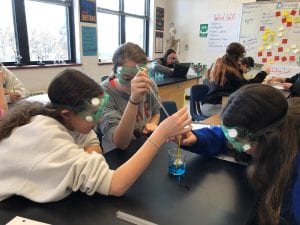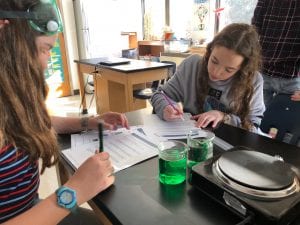The goal of the 8th grade Soap Boat Challenge was to SYSTEMATICALLY design a soap boat that would go the farthest distance. The “systematic” part was the key. Students were supposed to change one variable at a time to see how it affected the boats movement. However, this was easier said than done for many. Their excitement to succeed in the challenge (and win :)) made it difficult for many students to slow down and test variables in a systematic way. Student self-assessments, however, were telling in that they were able to articulate how they had been systematic or not and what they would have done differently next time. Many students posted their process and prototypes on their blogs. Check them out!
7th Grade-Did your egg survive the fall?
After lots of creating and designing and testing and revising, Monday marked the day the 7th graders dropped their egg apparatuses from the second floor window of the building. Some eggs lived; some didn’t. But, all 7th graders lived through and learned about the engineering process. Check out their blogs to see their final prototypes!
Welcome Back 7th and 8th Graders!
And, in the blink of an eye another school year begins…
After two days of adventure, building relationships and laughs and smiles, the 7th and 8th graders began the work of “doing” science and engineering. Several of the 7th graders asked me if the class to do an Egg Drop Challenge in which they have to design and construct an apparatus that will prevent an egg from breaking as it free falls from the window of the building. What? Kids excited and interested in an engineering challenge…game on! I was happy to make it happen :). The drop is on Monday so stay tuned for the results.
Meanwhile, the 8th graders were challenged to manipulate the variables of a soap boat system with the goal of making it go the farthest. Students changed the boat shape, boat size, amount of soap and many other things to see what might work best.
Throughout these days, I was reminded how “fast” students like to go. So many of them get lost in the excitement of the challenge that they forget to slow down and really plan and think through a challenge in a systematic way. This was a good reminder of how important it is for me to provide a framework that slows students down and encourages deep, critical thought while still allowing for free thinking and development of ideas. Ask your kids about their challenges!
How does this magnetic cannon work?

As part of their study of motion, the 8th graders have been trying to figure out how a magnetic cannon works. The cannon is a series of five metal ball bearings and a magnet as shown in the photo above. The single ball on the one end is rolled toward the system and only the last ball shoots out. This week the 8th graders are synthesizing all of the scientific principles they have learned about motion in order to create an infographic explaining how the magnetic cannon works. Creating the infographic required that kids really dig deep and really understand and apply their knowledge of forces, energy and Newton’s Laws of Motion. Ask them about how it works! 

![]()

Can we make soap from fat?
The 7th graders attempted to make soap yesterday by combining alcohol, salt, fat and sodium hydroxide. Is it possible to make soap out of other substances? How does this happen? They are still pondering these questions. But, they definitely all agree that there is evidence that a chemical reaction took place. How will they determine if the soap they made is actually a new substance? Stay tuned to find out.
How is fat and soap different?
The 7th graders have completed their study of energy and are beginning to explore matter and chemical reactions. They have been engaged in a series of experiments trying to explain properties of matter in order to describe how substances are the same and different. Thinking about matter and trying to understand it at the atomic level is tricky. Kids can’t see the things we are talking about. This unit will help them develop their ability to think abstractly and understand that there are many scientific processes at work that aren’t always obvious.
How will it move?
 This is the driving question the 8th graders have been pondering for the past two weeks. They have been analyzing a variety of apparatuses in order to determine how the forces exerted on each apparatus make it move. Students have examined Newton’s Cradle, a magnetic cannon, flying balloons and more. They’ve analyzed the role each component of the system plays in the objects movement and built models to explain their thinking. At times, the answers to why an object moves the way it does seems obvious. However, I’ve been challenging the students to really dig deep to understand the nuances that exist within these systems in order to be able to support their claims with effective evidence and reasoning.
This is the driving question the 8th graders have been pondering for the past two weeks. They have been analyzing a variety of apparatuses in order to determine how the forces exerted on each apparatus make it move. Students have examined Newton’s Cradle, a magnetic cannon, flying balloons and more. They’ve analyzed the role each component of the system plays in the objects movement and built models to explain their thinking. At times, the answers to why an object moves the way it does seems obvious. However, I’ve been challenging the students to really dig deep to understand the nuances that exist within these systems in order to be able to support their claims with effective evidence and reasoning.
Fingers crossed!
A lot has been going on the past few weeks in 8th grade. Two weeks ago, the nervous and excited 8th graders presented their building prototypes to a group of professors and graduate students at UWM. There, they explained their design and tested their structures on a shake table. Professors judged each designed and gave each group feedback. Congratulations to T.B. and E.G. for winning first place, O.F. and S.I. for winning second and E.A. and H.E. for winning third for their designs! And, congratulations to all for taking the time to slow down the design process in order to work through the engineering process with careful thought and consideration.



“Wow! Look at this!”
“It’s smoking!”
“It’s turning red!”
“It’s boiling!”
“Wow, it’s so hot!”
“It smells like chlorine!”
It was an exciting day in science class today! Seventh graders explored chemical energy by mixing copper chloride and aluminum. They used their quantitative and qualitative observations to determine that when these two substance were mixed a chemical reaction had occurred thereby creating energy.
How does our study of kinetic energy connect to thermal energy?
Last week, the 7th graders explored the connection between temperature, kinetic energy, molecular motion and thermal energy by analyzing what happens when you add food coloring to very hot versus very cold water. From this exploration they came up with a scientific definition for temperature. Ask them what it is!

